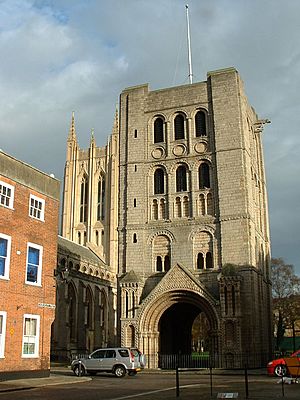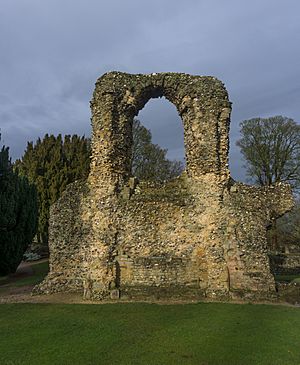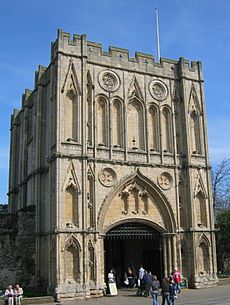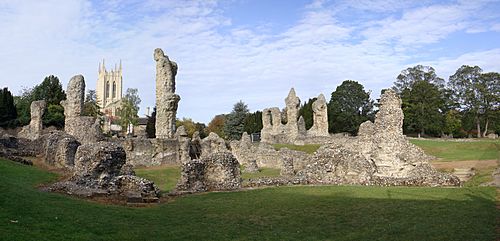Bury St Edmunds Abbey facts for kids
The Abbey of Bury St Edmunds was once one of the most powerful and wealthy Benedictine monasteries in England. It was a huge religious center until it was closed down in 1539 during the time known as the Dissolution of the monasteries. The Abbey is located in the town of Bury St Edmunds in Suffolk, England, which actually grew up around the Abbey itself.
People came from far and wide to visit the Abbey because it was the burial place of Saint Edmund. He was an Anglo-Saxon king who was killed in 869 by the Great Heathen Army of Danes. Today, most of the Abbey church and other buildings are just ruins. However, two very large medieval gatehouses still stand, along with two other old churches that were built inside the Abbey complex.
History of the Abbey
The area where the Abbey stands has been used for religious purposes for a very long time. In the early 900s, the remains of the martyred king, St Edmund, were moved here. This place was then called St Edmundsbury.
In 1020, during the reign of King Canute, the lands around the shrine were given to a small group of Benedictine monks. These monks were in charge of guarding St Edmund's shrine. The first two leaders, called abbots, of Bury were Ufi (who died in 1044) and Leofstan (1044–65).
After Leofstan died, King William the Conqueror chose his doctor, Baldwin, to be the abbot (1065–97). Baldwin rebuilt the church and moved St Edmund's body there with a big ceremony in 1095. Because of St Edmund, the Abbey became a very popular place for pilgrimages, which meant many people visited it.
The Abbey church of St Edmund was built between the 11th and 12th centuries. It was designed in a cross shape, with the main altar and St Edmund's shrine at the east end. The Abbey was made much larger and rebuilt during the 1100s. It was about 505 feet long and 246 feet wide at its western end, making it one of the biggest churches in England.
Today, the Abbey church is mostly ruins, with only some stone cores left. However, two other churches that were built within the Abbey grounds are still standing. These churches, St James's Church (now St Edmundsbury Cathedral) and St Mary's Church, have always served the local townspeople. St James's Church was finished around 1135. St Mary's Church was first built around 1125 and then rebuilt between 1425 and 1435 in a style called Perpendicular.
The Abbey Gate was the main entrance for the Abbey's workers and visitors. It opened into the Great Courtyard.
A special 12th-century cross, called the Cloisters Cross, was carved from walrus ivory. It is now in the Metropolitan Museum of Art in New York City. Some experts believe it was made at the Abbey.
In 1327, the Abbey was damaged during a big riot by local people. They were angry about the monastery's power, so the Abbey had to be rebuilt. The Norman Gate, built between 1120 and 1148, was the main entrance for the Abbey Church. It is still the bell tower for St James's Church, which is now the cathedral. This four-story gate is almost unchanged. The Abbey Gate is an impressive 14th-century stone gatehouse. It was the entrance to the Great Courtyard and still has its original portcullis (a heavy gate that slides down).
The Abbey had a fishpond called The Crankles and a vineyard that started in the 1200s. There were even three breweries, as each monk was allowed eight pints of drink a day!

The Abbey was given a lot of land and rights in Suffolk. By 1327, it owned all of West Suffolk. The monks controlled the town gates and even ran the Royal Mint. They also charged fees for almost every business activity, even for collecting horse droppings in the streets!
During the 1200s, people were generally happy, but in the 1300s, the monks faced a lot of anger from the local people. In 1327, there were many riots. Several monks were killed, and many buildings were destroyed. The townspeople attacked in January, forcing the monks to agree to a new charter of liberties. When the monks went back on their word, the people attacked again in February and May. They took and destroyed important documents like charters and debt records.
Things calmed down a bit on September 29, 1327, when Queen Isabella arrived at the Abbey with an army. She was returning from Europe to remove her husband, King Edward II, from power. She stayed at the Abbey for several days with her son, who would become King Edward III.
However, on October 18, 1327, some monks entered the local church. They took off their robes to show they were wearing armor underneath and took several people hostage. When citizens demanded the hostages be released, the monks threw objects at them, hurting some people. In response, the citizens swore to fight the Abbey. They burned the gates and took over the Abbey.
By 1345, a special investigation found that the monks were not always wearing their robes or living in the monastery as they should. The Abbey faced money problems and continued to decline in the early 1400s. In 1431, the west tower of the Abbey church fell down. Two years later, King Henry VI stayed at the Abbey for Christmas and remained there for four months! More trouble came in 1447 when the Duke of Gloucester died under strange circumstances after being arrested. In 1465, the entire church was accidentally burned down.
The Abbey was mostly rebuilt by 1506. It then had a quieter time until it was closed down in 1539. After that, all valuable building materials and items were taken from the Abbey. The ruins were left as a convenient place for local builders to get stone. In 1848, a collection of wolf skulls was found at the site.
Today, the ruins are owned by English Heritage and looked after by the St Edmundsbury Borough Council.
Abbey Gardens
The Abbey Gardens are owned by the St Edmundsbury Borough Council and managed with English Heritage. The Abbey ruins are located within these beautiful gardens. A group of friends helps to support the care and improvements of the gardens.
In 2001, an "Internet bench" was put in the Abbey Gardens. This was a special bench where people could connect their laptops to the internet. It was the first bench of its kind! There is also a sensory garden designed for people who are visually impaired.
Famous Burials
Many important people were buried at the Abbey of Bury St Edmunds:
- Jurmin
- Edmund the Martyr
- Alan Rufus (died 1093) was first buried outside the south door, then moved inside the Abbey church.
- Thomas of Brotherton (died 1338) was the Earl of Norfolk and Lord Marshal of England. He was the son of King Edward I and Margaret of France. He was buried in the choir area of the church.
- Princess Mary Tudor (died 1533), whose remains were moved to nearby St Mary's Church when the Abbey closed five years later.
In the late 1800s, a manuscript found in France showed where eighteen of the Abbey's abbots were buried. A historian named Montague R. James, who knew a lot about the Abbey, used this information. He supervised an excavation of the chapter house. On New Year's Day 1903, the coffins and remains of five of the abbots were shown to the public.








